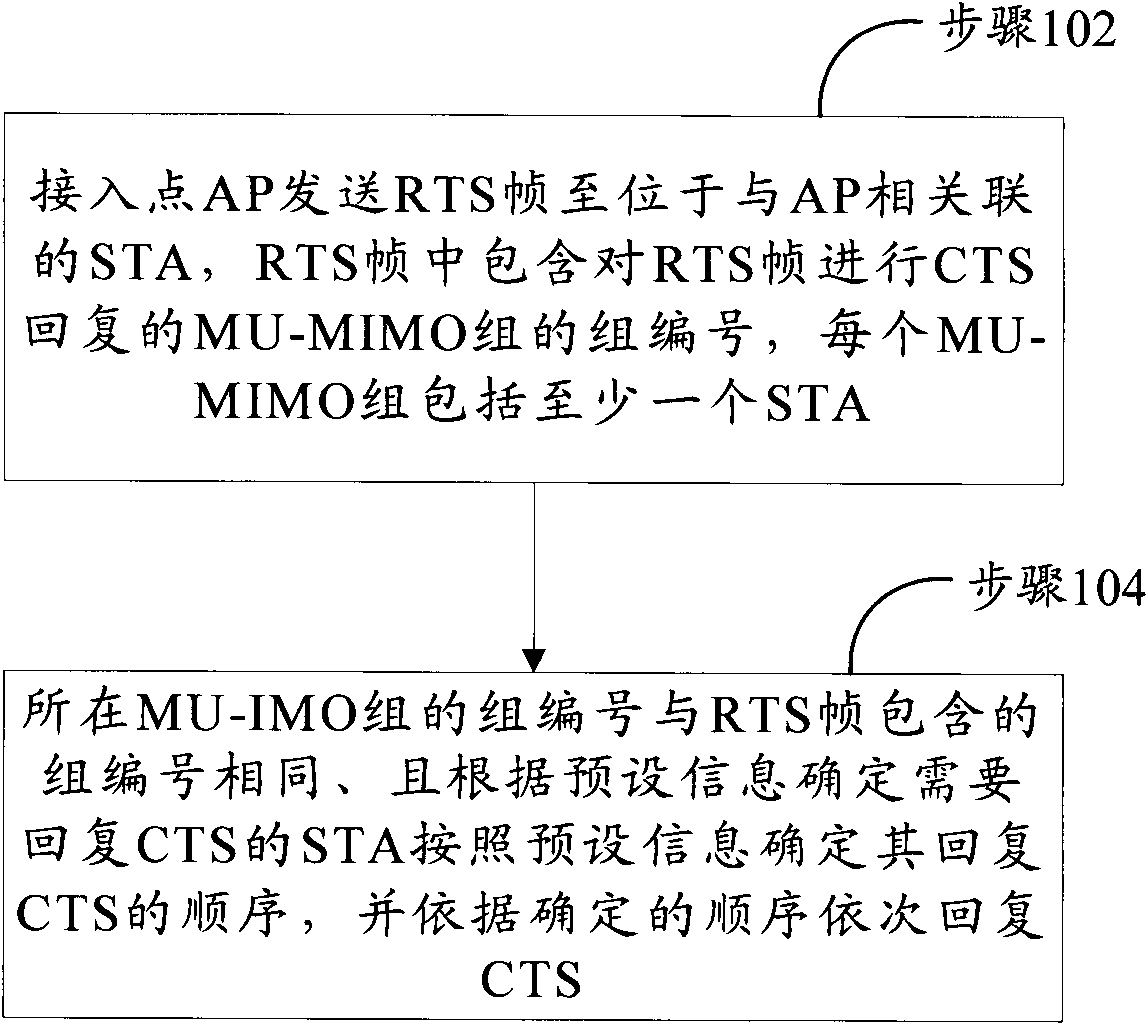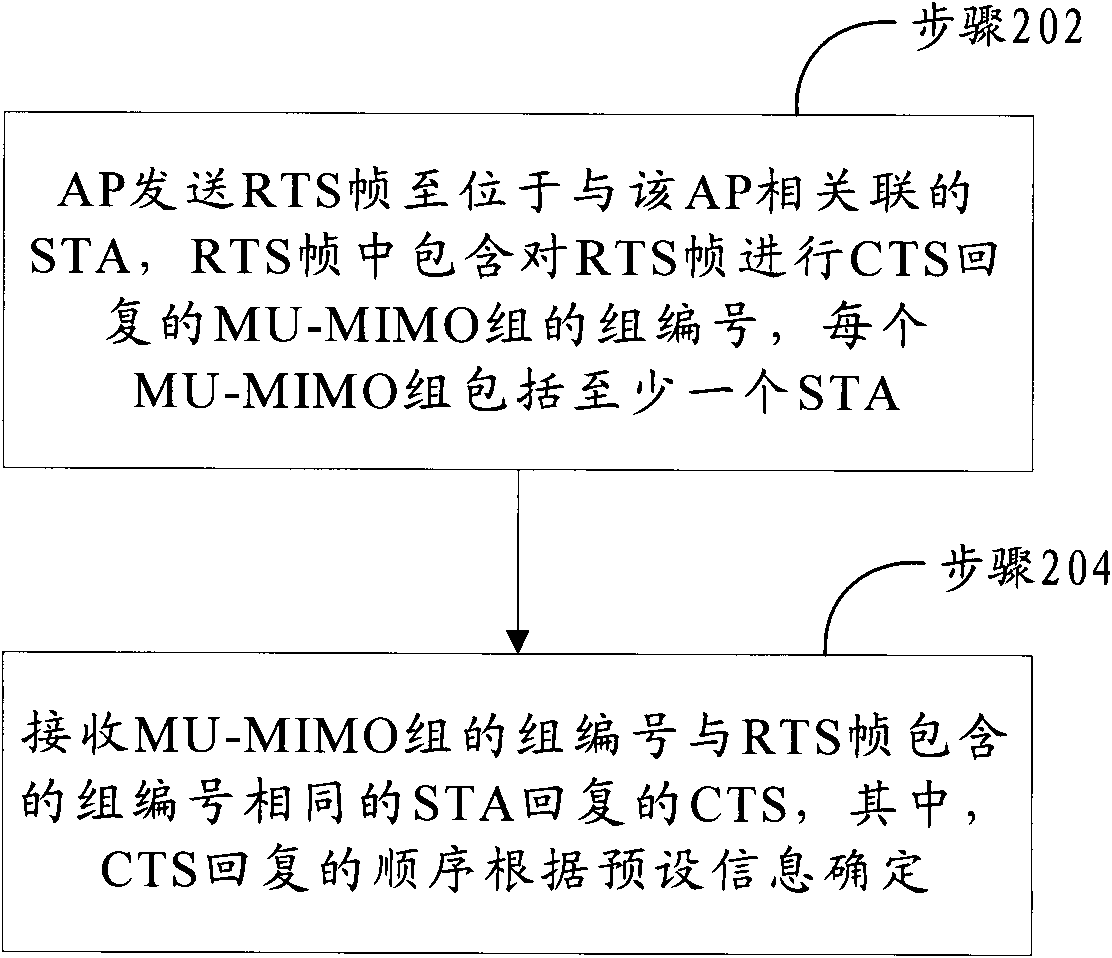Clear to send (CTS) reply method and system
A technology that allows sending and sending of requests. It is applied in the field of communication and can solve problems such as occupying large resources, channel congestion, and reducing control accuracy.
- Summary
- Abstract
- Description
- Claims
- Application Information
AI Technical Summary
Problems solved by technology
Method used
Image
Examples
Embodiment 1
[0055] Assume that there is 1 AP and 6 STAs associated with the AP in the network, and the 6 STAs are represented as STA-1, STA-2, STA-3, STA-4, STA-5, STA-6; each A MU-MIMO group consists of a maximum of 4 STAs, and a MU-MIMO group with less than 4 STAs is still considered to be composed of 4 STAs, and the insufficient part can be considered to have virtual STAs.
[0056] The AP divides the STAs into multiple MU-MIMO groups according to their channel state information, and notifies the corresponding STAs of the grouping information. Assuming that there are enough group numbers, each group number indicates only one MU-MIMO group, and one of the group numbers For (STA-2, STA-6, STA-4, STA-1), the group number GroupID=2, the AP publishes this MU-MIMO grouping information, the information includes the group number GroupID=2, and is arranged in the order in the brackets above The identifiers of the four STAs are assumed to be represented by the MAC addresses of the STAs.
[0057]...
Embodiment 2
[0072] Suppose there is 1 AP and 9 STAs associated with the AP in the network, and the 9 STAs are represented as STA-1, STA-2, STA-3, STA-4, STA-5, STA-6, STA- 7, STA-8, STA-9; each MU-MIMO group consists of up to 4 STAs, and the MU-MIMO group with less than 4 STAs is still considered to be composed of 4 STAs, and the insufficient part can be considered to have virtual STAs exist.
[0073] The AP divides each STA into multiple MU-MIMO groups according to their channel state information, and notifies the STAs of all the group information. Assuming that there are not enough group numbers, each group number can indicate multiple MU-MIMO groups. However, there are A constraint condition, if the same STA appears in multiple MU-MIMO groups indicated by the same group number, then the relative position of the STA in these groups is fixed.
[0074] If the group number GroupID=2 in this embodiment indicates three MU-MIMO groups, the three groups are (STA-5, STA-6, STA-7, STA-1), (STA-...
Embodiment 3
[0089] Suppose there is 1 AP and 9 STAs associated with the AP in the network, and the 9 STAs are represented as STA-1, STA-2, STA-3, STA-4, STA-5, STA-6, STA- 7, STA-8, STA-9; each MU-MIMO group consists of up to 4 STAs, and the MU-MIMO group with less than 4 STAs is still considered to be composed of 4 STAs, and the insufficient part can be considered to have virtual STAs exist.
[0090] The AP divides each STA into multiple MU-MIMO groups according to their channel state information, and notifies the STAs of all the group information. Assuming that there are not enough group numbers, each group number can indicate multiple MU-MIMO groups. However, there are A constraint condition, if the same STA appears in multiple MU-MIMO groups indicated by the same group number, then the relative position of the STA in these groups within the group is fixed.
[0091] If the group number GroupID=2 in this embodiment indicates three MU-MIMO groups, the three groups are (STA-5, STA-6, STA...
PUM
 Login to View More
Login to View More Abstract
Description
Claims
Application Information
 Login to View More
Login to View More - R&D
- Intellectual Property
- Life Sciences
- Materials
- Tech Scout
- Unparalleled Data Quality
- Higher Quality Content
- 60% Fewer Hallucinations
Browse by: Latest US Patents, China's latest patents, Technical Efficacy Thesaurus, Application Domain, Technology Topic, Popular Technical Reports.
© 2025 PatSnap. All rights reserved.Legal|Privacy policy|Modern Slavery Act Transparency Statement|Sitemap|About US| Contact US: help@patsnap.com



